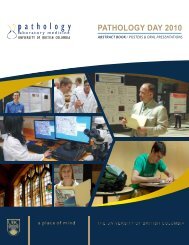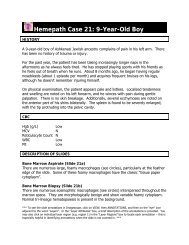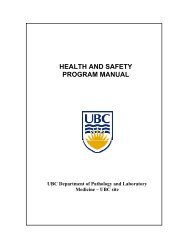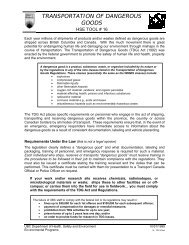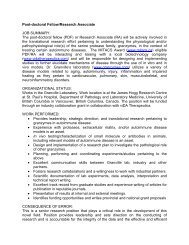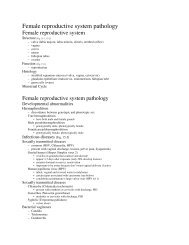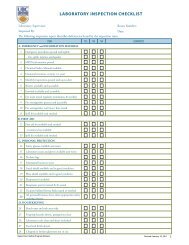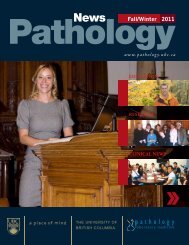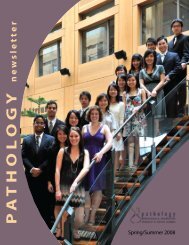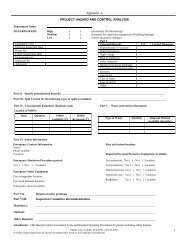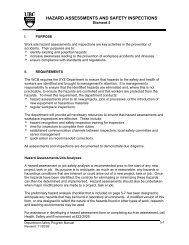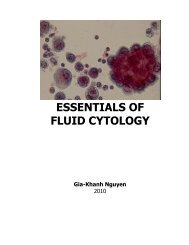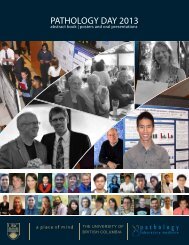ABSTRACT #26CLINICAL SCIENCESGRADUATE STUDENTPOSTER presentationIncreasing incidence <strong>of</strong> myasthenia gravis among elderly in British Columbia,Canada: 1984-2011Zahra Pakzad 1,2 , Tariq Aziz 2 , Joel Oger 1,21Department <strong>of</strong> <strong>Pathology</strong> <strong>and</strong> <strong>Laboratory</strong> <strong>Medicine</strong>, UBC; 2 Neuroimmunology <strong>Laboratory</strong>,Division <strong>of</strong> Neurology, Department <strong>of</strong> <strong>Medicine</strong>, UBCBackground /objectivesMyasthenia gravis (MG) is an antibody-mediated autoimmune disease <strong>of</strong> the neuromuscular junction,characterized by weakness <strong>and</strong> fatigability <strong>of</strong> skeletal muscle. The primary antigenic target in MG is the nicotinicacetylcholine receptor (AChR), a lig<strong>and</strong>-gated sodium channel located at high density on the post-synapticmuscle cell membrane. Anti-AChR antibodies are detected in sera <strong>of</strong> 80-90% <strong>of</strong> generalized MG patients <strong>and</strong>40-70% <strong>of</strong> patients with ocular MG. Their high specificity makes anti-AChR seropositivity an excellent surrogatemarker for MG. This study aimed to evaluate changes in the incidence <strong>and</strong> <strong>of</strong> anti-AChR antibody-seropositiveMG in British Columbia (BC), Canada, between the years <strong>of</strong> 1984 <strong>and</strong> 2011.38MethodsThe Neuroimmunology <strong>Laboratory</strong> at the <strong>University</strong> <strong>of</strong> British Columbia is the sole laboratory in BC thatprovides anti-AChR antibody testing for clinical diagnosis. Incident cases <strong>of</strong> anti-AChR seropositivity wereidentified by retrospectively identifying all first-time cases <strong>of</strong> anti-AChR antibody-seropositivity in theperiod <strong>of</strong> January 1984 to December 2011. Incidence was defined as the annual number <strong>of</strong> first-time anti-AChR seropositive cases. Incidence rates (IRs) were calculated per 1 million inhabitants based on annual Julypopulation estimates (www.bcstats.gov.bc.ca). Cases were stratified into four ages groups based on age at thefirst positive test: ≤19, 20-44, 45-64 <strong>and</strong> ≥65 years. Age- <strong>and</strong> sex-stratified IRs were calculated using populationestimates <strong>of</strong> the corresponding age <strong>and</strong> sex group.ResultsBetween January 1984 <strong>and</strong> December 2011, 1493 individuals were identified to be anti-AChR antibodyseropositive(767 women, 718 men, 8 unknown). In women the age at the first positive serum sample had abimodal distribution with peaks at 45-55 <strong>and</strong> 70-85 years, while in men there was a single peak at 70-80 years.The annual incidence <strong>of</strong> new AChR seropositivity has increased from 11.0/million (1984-1988 average) to 16.7/million (2007-2011 average). The incidence has most dramatically increased in the elderly (≥65 years), from 21.4/million (1984-1988 average) to 61.9/million (2007-2011 average). In contrast, the mean annual IRs <strong>of</strong> the threeyounger age groups has remained relatively constant over the 28-year period. These results confirm that the trendwe had described in an earlier report, <strong>of</strong> increasing incidence <strong>of</strong> elderly-onset anti-AChR seropositive MG in BCfor the period <strong>of</strong> 1984-2008, is continuing (Pakzad Z et al., Neurology 2011).ConclusionsOur results indicate a continually increasing incidence <strong>of</strong> elderly-onset anti-AChR seropositive MG in BC which isnot due to demographic changes. This trend could be due to improved diagnosis <strong>of</strong> MG in elderly patients over thedecades, or a true increase in the incidence due to as yet undefined reasons.2012 * Oral/Poster Presentations
POSTER presentationRESIDENTCLINICAL SCIENCESABSTRACT #27Regulatory T cells in CNS inflammationFahad A Alghamdi 1 , Wayne Moore 1 , Katerina Dorovini-Zis 11<strong>University</strong> <strong>of</strong> British Columbia <strong>and</strong> Vancouver General HospitalBackground /objectivesRegulatory T cells (Tregs) are thymus-derived CD4+ CD25+T lymphocytes that play an important role inmaintenance <strong>of</strong> self-tolerance <strong>and</strong> suppression <strong>of</strong> autoimmunity. Tregs recognize both self <strong>and</strong> foreign antigens<strong>and</strong> operate at sites <strong>of</strong> inflammation by suppressing the function <strong>of</strong> effector T cells, thus modulating theintensity <strong>and</strong> quality <strong>of</strong> immune responses. Their identification is based on the expression <strong>of</strong> activation markers<strong>and</strong> the forkhead transcription factor P3 (Foxp3). The contribution <strong>of</strong> Tregs to CNS inflammatory diseases hasnot been previously addressed.MethodsWe investigated the presence <strong>and</strong> distribution <strong>of</strong> Tregs in cases <strong>of</strong> multiple sclerosis (MS), primary CNS angiitis,sarcoidosis, bacterial, viral <strong>and</strong> parasitic infections, acute infarction <strong>and</strong> normal brain. Formalin fixed, paraffinembedded sections <strong>of</strong> surgical <strong>and</strong> autopsy material were stained with the indirect immunoperoxidase techniqueusing monoclonal anti-Foxp3, CD4 <strong>and</strong> CD8 antibodies.ResultsCD4+Foxp3+Tregs were present within the perivascular chronic inflammatory infiltrates in primary CNSangiitis <strong>and</strong> active MS lesions, but not in chronic inactive MS plaques. In sarcoidosis, tuberculosis, viralinfections <strong>and</strong> abscesses, frequent Tregs were identified in perivascular location <strong>and</strong> scattered in the inflamedtissue. A smaller number were present in parasitic <strong>and</strong> fungal infections <strong>and</strong> in leptomeningeal exudates inbacterial meningitis. Tregs were absent in the normal brain <strong>and</strong> acute ischemic lesions.ConclusionsThe present study shows participation <strong>of</strong> Tregs in autoimmune <strong>and</strong> infectious diseases suggesting a compleximmune regulatory role in CNS inflammation.Oral/Poster Presentations * 2012 39



